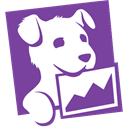Top Octopussy Alternatives for Robust Log Management
Octopussy, a well-known log management solution, has been a go-to for many organizations looking to centralize and analyze their log data. However, with evolving business needs and technological advancements, many users are now searching for an Octopussy alternative that offers enhanced features, better scalability, or different pricing models. This article explores some of the leading contenders that can step in to provide comprehensive log management and beyond.
Best Octopussy Alternatives
Whether you're seeking open-source flexibility, advanced analytics, or broader IT infrastructure monitoring, these alternatives offer compelling solutions to meet your log management requirements.

Datadog
Datadog is a comprehensive monitoring service designed for IT, Dev & Ops teams managing applications at scale. It's an excellent commercial Octopussy alternative for those who need more than just log management, offering APM monitoring, cloud monitoring, error logging, network monitoring, performance monitoring, and server monitoring across Mac, Windows, Linux, and Web platforms. Its SaaS model provides real-time insights from massive amounts of data.

Graylog
Graylog is a powerful open-source syslog implementation that stores logs in Elasticsearch, making it a strong Octopussy alternative for users seeking a free and self-hosted solution. Available for Mac and Linux, Graylog provides robust log indexing and general logging capabilities through its Java-based server and web interface.

Splunk
Splunk is a leading freemium software that offers unique visibility across an entire IT infrastructure in real time. As an Octopussy alternative, Splunk excels in capturing logs, content searching, data analytics, log parsing, and log storage across Mac, Windows, and Linux, making it ideal for organizations needing advanced analytical power.

Nagios Log Server
Nagios Log Server is a powerful enterprise-class log monitoring and management application. This commercial Octopussy alternative, available for Windows, Linux, Web, and Self-Hosted environments, allows organizations to quickly view, sort, and configure logs, boasting features like data analytics, hardware monitoring, logging, network monitoring, and web log analysis.

IQLECT
IQLECT is a freemium, web-based real-time big data analytics platform. It stands out as an Octopussy alternative for its focus on log data, machine data, app data, and clickstreams, offering features like log analytics, NoSQL database support, real-time analytics, services monitoring, and tracking of real-time data.

XpoLog
XpoLog is a freemium log analysis and management platform known for its super fast index and search capabilities. Available for Mac, Windows, Linux, and Web, it serves as an excellent Octopussy alternative for mission-critical operations, providing error logging, general logging, and web log analysis.

CloudMonix
CloudMonix is a freemium cloud monitoring and automation service built with MSPs, CSPs, and DevOps in mind, primarily for Azure and AWS. This web-based Octopussy alternative offers extensive features including cloud monitoring, application monitoring, auto scaling, hardware monitoring, logging, network monitoring, performance monitoring, server monitoring, services monitoring, uptime monitoring, and website monitoring.

OTUS SIEM
Otus is a commercial provider of SIEM, log management, and event management equipment for enterprises. Available for Mac, Windows, Linux, and BSD, it's a robust Octopussy alternative for organizations prioritizing comprehensive security information and event management and web log analysis.

Sawmill
Sawmill is a commercial, universal log analysis/reporting tool compatible with almost any log type, including web, media, email, security, network, and application logs. Supporting Mac, Windows, and Linux, it serves as a powerful Octopussy alternative focusing primarily on in-depth web log analysis.
Exploring these Octopussy alternatives allows you to find a log management solution that aligns perfectly with your specific operational needs, budget, and infrastructure. Evaluate their features, platforms, and pricing to determine the best fit for your organization's future growth and efficiency.